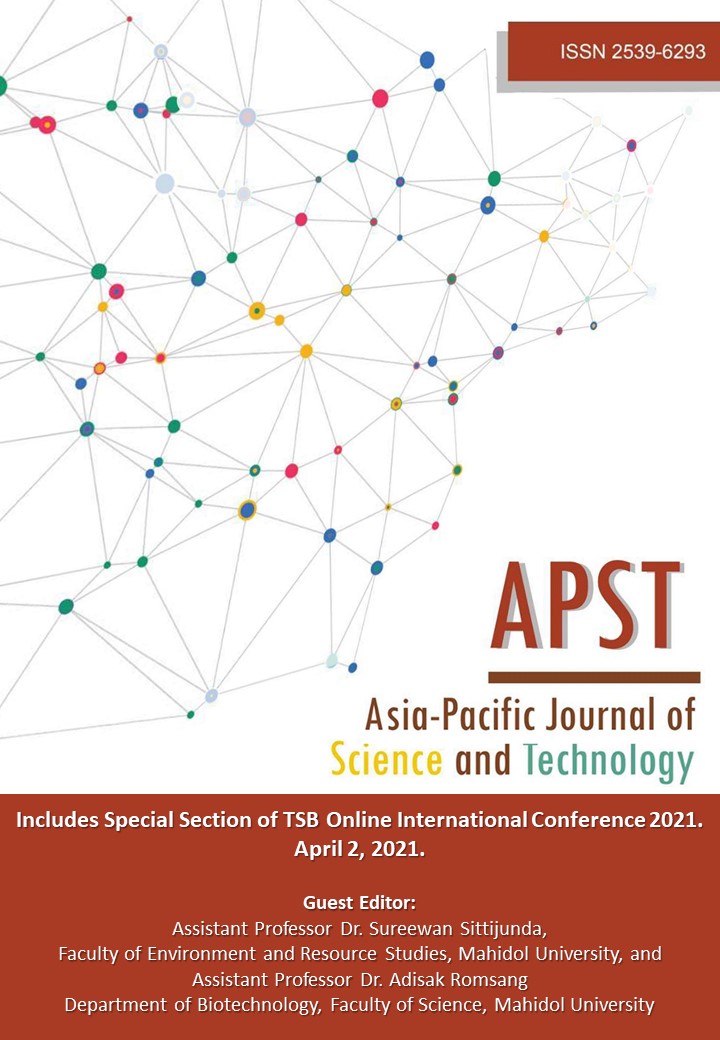In-vitro evaluation of actinomycetes with plant growth-promoting properties
Main Article Content
Abstract
The aim of this study was to evaluate actinomycetes for plant growth-promoting (PGP) traits using in vitro experiments. Actinomycetes were isolated from two different soil rhizospheres and subjected to dual culture experiments in order to determine antimicrobial activity. Subsequently, selected isolates with potent antimicrobial activity were examined further for their ability to biosynthesize indole-3-acetic acid (IAA) and siderophores, solubilize inorganic phosphate, and produce ammonia. Results showed that these strains produced 38.73-211.35 ng/mL IAA in Tryptic Soy Broth (TSB), and solubilized 116.20-319.33 µg/mL inorganic phosphate in National Botanical Research Institute's phosphate growth medium (NBRIP) broth. Additionally, all selected actinomycetes produced siderophores in chrome azurol S (CAS) agar and ammonia in peptone water. Five isolates showed promise as plant growth promoters, with isolates SNN045, SNN056, and SNN059 being the most plausible candidates for agricultural applications.
Article Details

This work is licensed under a Creative Commons Attribution-NonCommercial-NoDerivatives 4.0 International License.
References
The United Nations. World population projected to reach 9.8 billion in 2050, and 11.2 billion in 2100. Department of Economic and Social Affairs, New York. 2017.
Aktar MW, Sengupta D, Chowdhury A. Impact of pesticides use in agriculture: their benefits and hazards. Interdisciplinary Toxicology. 2009;2(1):1-12.
Gold M. "What is organic production?". National Agricultural Library. USDA. 2014.
Glick BR, Patten CL, Holguin G, Penrose DM. Biochemical and genetic mechanisms used by plant growth promoting bacteria. Imperial College Press, London, UK. 1999:1-13.
Dias MP, Bastos MS, Xavier VB, Cassel E, Astarita LV, Santarém ER. Plant growth and resistance promoted by Streptomyces spp. in tomato. Plant Physiol Biochem. 2017;118:479-493.
Lee SM, Kong HG, Song GC, Ryu CM. Disruption of firmicutes and Actinomycetes abundance in tomato rhizosphere causes the incidence of bacterial wilt disease. The ISME J, 2021;15(1):330-347.
Solís-García IA, Ceballos-Luna O, Cortazar-Murillo EM, Desgarennes D, Garay-Serrano E, Patiño-Conde V, et al. Phytophthora root rot modifies the composition of the avocado rhizosphere microbiome and increases the abundance of opportunistic fungal pathogens. Front Microbiol. 2021;11:574110.
Vurukonda SSKP, Giovanardi D, Stefani E. Plant growth promoting and biocontrol activity of Streptomyces spp. as endophytes. Int J Mol Sci. 2018;19(4):952.
Onofre SB, Antoniazzi D. Behavior of the fungus Colletotrichum gloeosporioides (Penz & Sacc.), which causes bitter rot in apples after harvesting. Adv Microbiol. 2014;4:202-206.
Drenth A, Sendall B. Economic impact of Phytophthora diseases in Southeast Asia. In Diversity and Management of Phytophthora in Southeast Asia, edited by Drenth, A. & Guest, D.I. ACIAR Monograph. 2004;114:10-28,97-99.
Kone D, Dao S, Tekete C, Doumbia I, Koita O, Abo K, et al. Confirmation of Xanthomonas axonopodis pv. manihotis causing cassava bacterial blight in Ivory Coast. Plant Dis. 2015;99:1445.
Vicente JG, Holub EB. Xanthomonas campestris pv. campestris (cause of black rot of crucifers) in the genomic era is still a worldwide threat to brassica crops. Mol Plant Pathol. 2013;14(1):2-18.
Carreño-Lopez R, Campos-Reales N, Elmerich C, Baca BE. Physiological evidence for differently regulated tryptophan-dependent pathways for indole-3-acetic acid synthesis in Azospirillum brasilense. Mol genet Genom. 2000;264(4):521-530.
Murphy J, Riley JP. A modified single solution method for the determination of phosphate in natural waters. Anal Chim Acta. 1962;27:31-36.
Schwyn B, Neilands JB. Universal chemical assay for the detection and determination of siderophores. Anal Biochem. 1987;160:47-56.
Gopalakrishnan S, Pande S, Sharma M, Humayun P, Kiran BK, Sandeep D, et al. Evaluation of Actinomycete isolates obtained from herbal vermicompost for the biological control of Fusarium wilt of chickpea. Crop Protection. 2011;30:1070-1078.
Hastuti RD, Lestari Y, Saraswati R, Suwanto A. Capability of Streptomyces spp. in controlling bacterial leaf blight disease in rice plants. Am J Agric Biol Sci. 2012;7:217-223.
Kanini GS, Katsifas EA, Savvides AL, Hatzinikolaou DG, Karagouni AD. Greek indigenous streptomycetes as biocontrol agents against the soil-borne fungal plant pathogen Rhizoctonia solani. J Appl Microbiol. 2013;114:1468-1479.
Behie SW, Bonet B, Zacharia VM, McClung DJ, Traxler MF. Molecules to Ecosystems: Actinomycete natural products In situ. Front Microbiol. 2017;7:2149.
Myo EM, Ge B, Ma J, Cui H, Liu B, Shi L, et al. Indole-3-acetic acid production by Streptomyces fradiae NKZ-259 and its formulation to enhance plant growth. BMC Microbiol. 2019;19:155.
Apine OA, Jadhav JP. Optimization of medium for indole-3-acetic acid production using Pantoea agglomerans strain PVM. J Appl Microbiol. 2011;110(5):1235-1244.
Ivanchenko MG, Napsucialy-Mendivil S, Dubrovsky JG. Auxin-induced inhibition of lateral root initiation contributes to root system shaping in Arabidopsis thaliana. Planta. 2010;64(5):740-752.
Jog R, Pandya M, Nareshkumar G, Rajkumar S. Mechanism of phosphate solubilization and antifungal activity of Streptomyces spp. isolated from wheat roots and rhizosphere and their application in improving plant growth. Microbiol. 2014;160:778-788.
Farhat MB, Boukhris I, Chouayekh H. Mineral phosphate solubilization by Streptomyces sp. CTM396 involves the excretion of gluconic acid and is stimulated by humic acids. FEMS Microbiol Lett. 2015;362(5):fnv008.
Trivedi P, Leach JE, Tringe SG, Sa T, Singh BK. Plant-microbiome interactions: from community assembly to plant health. Nat Rev Microbiol. 2020;18(11):607-621.
Ahmed E, Holmström SJ. Siderophores in environmental research: roles and applications. Microb Biotechnol. 2014;7(3):196-208.
Palaniyandi SA, Yang SH, Zhang L, Suh JW. Effects of actinomycetes on plant disease suppression and growth promotion. Appl Microbiol Biotechnol. 2013;97:9621-9636.
Sreevidya M, Gopalakrishnan S, Kudapa H, Varshney RK. Exploring plant growth-promotion actinomycetes from vermicompost and rhizosphere soil for yield enhancement in chickpea. Braz J Microbiol. 2016;47(1):85-95.


